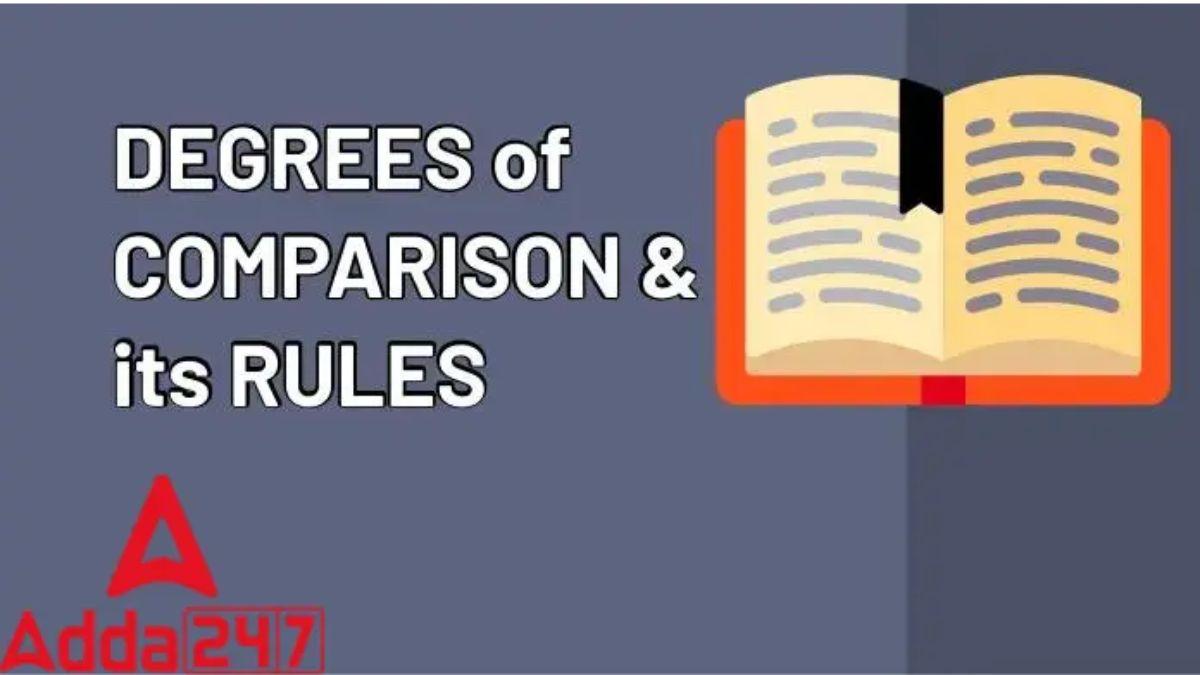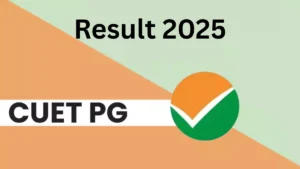Table of Contents
Degree of comparison refers to the different forms of an adjective or adverb that indicate the intensity or relative quality of a person, thing, or action. There are three degrees of comparison: positive, comparative, and superlative. In this article, you will learn the definition of degree of comparison, the all facts about different degrees of comparison, how they can be used and the rules to be followed when using them along with examples.
Degree of Comparison
In Modern English grammar, words used to describe the meaning and give more information about the nouns in a particular sentence or context are known as adjectives. Sometimes, there might be more than one noun that possesses the same quality as another one or sometimes, even better than one or more of the other nouns involved. n other words, To make a comparison between nouns with comparable quality or attributes of similar qualities, we can make use of a degree of comparison.
What is Degrees of Comparison?
In English grammar, degree of comparison is used to compare the attributes or features of distinct people, things, or actions. A degree of comparison is a type of adjective in the English language that is used to compare one person or object with another that has the same quality. It is similar to an adjective or an adverb in a sentence. Positive, comparative, and superlative comparisons are the three levels of comparison.
Degrees of Comparison Definition
The degrees of comparison is a type of adjective used in English to contrast one thing or person with another that shares the same attribute. It is connected to the sentence’s adjective or adverb. The listing of an adjective or adverb’s positive, comparative, and superlative forms is what the Collins Dictionary refers to as the “degree of comparison.” In other words, it can be claimed that one can compare nouns that have similar properties or attributes using the degree of comparison.
Types of Degrees of Comparison
There are three types of degrees of comparison:
- Positive degree of comparison.
- Comparative degree of comparison.
- Superlative degree of comparison.
Let’s take a closer look at each of the different types of degree of comparison mentioned above.
Positive Degree of Comparison
The adjective’s original form is essentially the positive degree of comparison. You cannot draw any comparisons with this degree. It simply informs the audience of a certain characteristic a noun possesses.
Positive Degree Examples
- The giraffe is tall.
- The dress is pretty.
- My friend is happy.
- The Sun is bright.
Comparative Degree of Comparison
To compare two nouns that share the same characteristic or the same quality at two separate times, use the comparative degree of comparison. It demonstrates which of the two possesses the referred-to quality to a greater or lesser degree.
Comparative Degree Examples
- Tisha looks happier than Kylie.
- This couch is more comfortable than the other couch.
- Your hair is shorter than hers.
- My younger brother is taller than me.
Superlative Degree of Comparison
The highest level of comparison is a superlative comparison. It is used to compare the similar characteristics that more than two nouns have in common. It reveals which of the nouns under comparison possesses the mentioned attribute or qualities to the greatest or least degree.
Superlative Degree Examples
- Tisha is the most intelligent student among all the students.
- This couch is the most comfortable.
- Shivani is the tallest girl in our gang.
- My younger brother is the heaviest among all the family members.
Degrees of Comparison Rules
The degrees of comparison include some rules and criteria that you must keep in mind, just like any other grammar element in English. Look at the following.
- Degree of comparison are used to compare adjectives and adverbs, which is the first thing you should keep in mind regarding them.
- The base form of the adjective or adverb, which allows no comparison, is called the positive degree of comparison.
- In order to compare two nouns that share or lack the same features, the comparative degree of comparison is used. The suffix “-er” at the end of the adjective serves as the primary indicator.
- After the comparative form of the adjective, “than” is always added to show the comparative degree of comparison.
- To demonstrate which noun possesses the most or least amount of a quality or set of attributes, the superlative degree of comparison is utilised. The usage indicates it.
Degrees of Comparison Examples with Answers
Degrees of comparison are used in grammar to show the degree of a quality or characteristic of a person, thing, or idea. The three degrees of comparison are the positive, comparative, and superlative degrees. Here are some examples of each:
- Positive degree: The positive degree is the simple form of an adjective or adverb that does not compare one thing to another.
- The sun is hot.
- She is beautiful.
- He sings well.
- Comparative degree: The comparative degree is used to compare two things and is formed by adding -er to the end of the adjective or by using “more” before the adverb.
- The sun is hotter than the moon.
- She is more beautiful than her sister.
- He sings better than his friend.
- Superlative degree: The superlative degree is used to compare more than two things and is formed by adding -est to the end of the adjective or by using “most” before the adverb.
- The sun is the hottest star in the sky.
- She is the most beautiful woman in the world.
- He sings the best out of all his classmates.
Note that some adjectives and adverbs have irregular comparative and superlative forms. For example:
- Good -> Better -> Best
- Bad -> Worse -> Worst
- Well -> Better -> Best
- Far -> Farther/Further -> Farthest/Furthest
Examples of Degrees of Comparison in English
The following table consists of examples of all three degrees of comparison.
| POSITIVE | COMPARATIVE | SUPERLATIVE |
| She is tall. | She is taller than her brother. | She is the tallest among her family. |
| Mira is happy. | Mira is happier than her mother. | Mira is the happiest person in the class. |
| Sumi is beautiful. | Sumi is more beautiful than her sister. | Sumi is the most beautiful girl in her house. |
| Food is good. | The food here is better than that restaurant. | The food here is the best than other restaurants. |
| Rina has a big house. | Rina has a bigger house than his father’s. | Rina has the biggest house. |
Before you look at some examples, keep in mind that not all adjectives follow the rule to add “-er” and “-est” to make the comparative and superlative degree of comparison. The various types consist of the following:
Type 1: Adding the suffixes “-er” and “-est” to a monosyllabic adjective’s last consonant.
Type 2: Adding the suffixes “-er” and “-est” to monosyllabic adjectives in which the final consonant is followed by a different consonant or by two vowels.
Type 3: Adjectives ending in “e” are given the “-r” and “-st” suffixes in Type 3.
Type 4: Adjectives with a ‘y’ ending are given the suffixes -ier and -iest.
Type 5: Adding “more” and “most” to adjectives with multiple syllables.
Type 6: Adjectives of Type 6 are irregular
Here is a list of examples of degree of comparison that you can look upon for a better understanding.
Type 1
| Positive | Comparative | Superlative |
| Big | Bigger | Biggest |
| Thin | Thinner | Thinnest |
| Fat | Fatter | Fattest |
| Dim | Dimmer | Dimmest |
| Hot | Hotter | Hottest |
| Sad | Sadder | Saddest |
| Slim | Slimmer | Slimmest |
| Red | Redder | Reddest |
Type 2
| Positive | Comparative | Superlative |
| Bright | Brighter | Brightest |
| Short | Shorter | Shortest |
| Weak | Weaker | Weakest |
| Long | Longer | Longest |
| Smart | Smarter | Smartest |
| Cool | Cooler | Coolest |
| Dark | Darker | Darkest |
| Small | Smaller | Smallest |
| Bold | Bolder | Boldest |
| Clever | Cleverer | Cleverest |
| High | Higher | Highest |
| Tall | Taller | Tallest |
| Sweet | Sweeter | Sweetest |
| Deep | Deeper | Deepest |
| Rich | Richer | Richest |
| Fast | Faster | Fastest |
| Thick | Thicker | Thickest |
| Great | Greater | Greatest |
| Kind | Kinder | Kindest |
| Cheap | Cheaper | Cheapest |
| Young | Younger | Youngest |
| Fast | Faster | Fastest |
| Stout | Stouter | Stoutest |
| Black | Blacker | Blackest |
| Slow | Slower | Slowest |
| Tight | Tighter | Tightest |
| Quick | Quicker | Quickest |
| Narrow | Narrower | Narrowest |
| Broad | Broader | Broadest |
Type 3
| Positive | Comparative | Superlative |
| Large | Larger | Largest |
| Close | Closer | Closest |
| Dense | Denser | Densest |
| Humble | Humbler | Humblest |
| Simple | Simpler | Simplest |
| Fine | Finer | Finest |
| Noble | Nobler | Noblest |
| Brave | Braver | Bravest |
| Pale | Paler | Palest |
| Nice | Nicer | Nicest |
Type 4
| Positive | Comparative | Superlative |
| Funny | Funnier | Funniest |
| Happy | Happier | Happiest |
| Dry | Drier | Driest |
| Lazy | Lazier | Laziest |
| Easy | Easier | Easiest |
| Heavy | Heavier | Heaviest |
| Wealthy | Wealthier | Wealthiest |
| Healthy | Healthier | Healthiest |
| Costly | Costlier | Costliest |
| Busy | Busier | Busiest |
| Cosy | Cosier | Cosiest |
| Dirty | Dirtier | Dirtiest |
Type 5
| Positive | Comparative | Superlative |
| Comfortable | More comfortable | Most comfortable |
| Beautiful | More beautiful | Most beautiful |
| Sensible | More sensible | Most sensible |
| Ignorant | More ignorant | Most ignorant |
| Attractive | More attractive | Most attractive |
| Important | More important | Most important |
| Courageous | More courageous | Most courageous |
| Faithful | More faithful | Most faithful |
| Elegant | More elegant | Most elegant |
| Active | More active | Most active |
| Popular | More popular | Most popular |
| Awesome | More awesome | Most awesome |
| Loyal | More loyal | Most loyal |
| Fantastic | More fantastic | Most fantastic |
| Wonderful | More wonderful | Most wonderful |
| Splendid | More splendid | Most splendid |
| Famous | More famous | Most famous |
| Difficult | More difficult | Most difficult |
| Careful | More careful | Most careful |
| Brilliant | More brilliant | Most brilliant |
| Enthusiastic | More enthusiastic | Most enthusiastic |
| Suitable | More suitable | Most suitable |
| Spacious | More spacious | Most spacious |
| Devoted | More devoted | Most devoted |
| Proper | More proper | Most proper |
| Patient | More patient | Most patient |
| Amazing | More amazing | Most amazing |
| Intelligent | More intelligent | Most intelligent |
| Likely | More likely | Most likely |
| Careless | More careless | Most careless |
| Threatening | More threatening | Most threatening |
| Magnificent | More magnificent | Most magnificent |
| Depressed | More depressed | Most depressed |
| Excited | More excited | Most excited |
| Amusing | More amusing | Most amusing |
Type 6
| Positive | Comparative | Superlative |
| Good | Better | Best |
| Bad | Worse | Worst |
| Far | Further/Farther | Furthest/Farthest |
| Late | Later(time)/Latter(position) | Latest(time)/Last(position) |
| Much | More | Most |
| Little | Less | Least |
| Many | More | Most |
| Old | Elder/Older | EldestOldest |
Degrees of Comparison 100 Examples
Very Important 100 examples of degrees of comparison (positive, comparative, and superlative forms) in English given below. The positive degree is the base form of an adjective, the comparative compares two things, and the superlative compares more than two.
- Small – smaller – smallest
- Big – bigger – biggest
- Tall – taller – tallest
- Short – shorter – shortest
- Long – longer – longest
- Strong – stronger – strongest
- Weak – weaker – weakest
- Fast – faster – fastest
- Slow – slower – slowest
- Heavy – heavier – heaviest
- Light – lighter – lightest
- Old – older – oldest
- Young – younger – youngest
- Hot – hotter – hottest
- Cold – colder – coldest
- Warm – warmer – warmest
- Brave – braver – bravest
- Clever – cleverer – cleverest
- Quiet – quieter – quietest
- Rich – richer – richest
- Poor – poorer – poorest
- Thick – thicker – thickest
- Thin – thinner – thinnest
- Wide – wider – widest
- Narrow – narrower – narrowest
- Bright – brighter – brightest
- Dark – darker – darkest
- Deep – deeper – deepest
- High – higher – highest
- Low – lower – lowest
- Clean – cleaner – cleanest
- Dirty – dirtier – dirtiest
- Pretty – prettier – prettiest
- Ugly – uglier – ugliest
- Happy – happier – happiest
- Sad – sadder – saddest
- Angry – angrier – angriest
- Friendly – friendlier – friendliest
- Easy – easier – easiest
- Hard – harder – hardest
- Near – nearer – nearest
- Far – farther/further – farthest/furthest
- Fine – finer – finest
- Nice – nicer – nicest
- Tough – tougher – toughest
- Safe – safer – safest
- Dangerous – more dangerous – most dangerous
- Expensive – more expensive – most expensive
- Famous – more famous – most famous
- Important – more important – most important
- Popular – more popular – most popular
- Comfortable – more comfortable – most comfortable
- Interesting – more interesting – most interesting
- Beautiful – more beautiful – most beautiful
- Delicious – more delicious – most delicious
- Generous – more generous – most generous
- Curious – more curious – most curious
- Honest – more honest – most honest
- Polite – more polite – most polite
- Active – more active – most active
- Creative – more creative – most creative
- Intelligent – more intelligent – most intelligent
- Attractive – more attractive – most attractive
- Comfortable – more comfortable – most comfortable
- Exciting – more exciting – most exciting
- Important – more important – most important
- Powerful – more powerful – most powerful
- Efficient – more efficient – most efficient
- Difficult – more difficult – most difficult
- Awful – more awful – most awful
- Careful – more careful – most careful
- Dangerous – more dangerous – most dangerous
- Faithful – more faithful – most faithful
- Horrible – more horrible – most horrible
- Confident – more confident – most confident
- Delightful – more delightful – most delightful
- Useful – more useful – most useful
- Powerful – more powerful – most powerful
- Successful – more successful – most successful
- Excited – more excited – most excited
- Advanced – more advanced – most advanced
- Accurate – more accurate – most accurate
- Efficient – more efficient – most efficient
- Obedient – more obedient – most obedient
- Patient – more patient – most patient
- Confusing – more confusing – most confusing
- Expensive – more expensive – most expensive
- Amazing – more amazing – most amazing
- Reliable – more reliable – most reliable
- Understanding – more understanding – most understanding
- Fantastic – more fantastic – most fantastic
- Convenient – more convenient – most convenient
- Sensitive – more sensitive – most sensitive
- Valuable – more valuable – most valuable
- Innovative – more innovative – most innovative
- Flexible – more flexible – most flexible
- Aggressive – more aggressive – most aggressive
- Respectful – more respectful – most respectful
- Effective – more effective – most effective
- Efficient – more efficient – most efficient
These examples cover a wide range of adjectives, showing how their comparative and superlative forms are used in English.
Degrees of Comparison Exercise
Exercise based on the degree of comparison is given below assess yourself by doing this:
- No other girl is as ……………………. as Jane. (tall / taller / tallest)
2. Milk is ………………….. than any other food. (nourishing / more nourishing / most nourishing)
3. Radium is one of the ……………………… metals. (valuable / more valuable / most valuable)
4. Few English poets were as ……………………. as Wordsworth. (great / greater / greatest)
5. Shimla is ………………….. than most other hill stations in India. (famous / more famous / most famous)
6. Gold is one of the ……………………. metals. (precious / more precious / most precious)
7. Solomon was …………………… than any other king. (wise / wiser / wisest)
8. Few historians write as ………………….. as Macaulay. (well / better /best)
9. Very few books are as ……………………. as David Copperfield. (popular / more popular / most popular)
10. A train is …………………. than a car. (fast / faster / fastest)
Check Yourself
- No other girl is as tall as Jane.
2. Milk is more nourishing than any other food.
3. Radium is one of the most valuable metals.
4. Few English poets were as great as Wordsworth.
5. Shimla is more famous than most other hill stations in India.
6. Gold is one of the most precious metals.
7. Solomon was wiser than any other king.
8. Few historians write as well as Macaulay.
9. Very few books are as popular as David Copperfield.
10. A train is faster than a car.
| Related Posts | |
| Nouns | Pronouns |
| Adverbs | Prepositions |





 CUET PG Result 2025 Soon @exams.nta.ac.i...
CUET PG Result 2025 Soon @exams.nta.ac.i...
 NEET Admit Card 2025 Release Date, How t...
NEET Admit Card 2025 Release Date, How t...
 CUET UG 2025 Vs CUET UG 2024, Check Majo...
CUET UG 2025 Vs CUET UG 2024, Check Majo...










